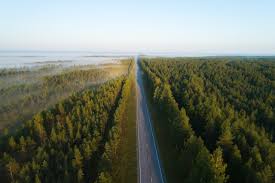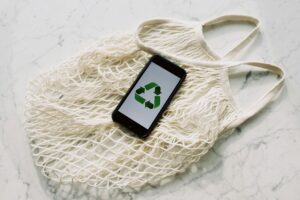The circular economy represents a fundamental shift in how we produce, consume, and dispose of products and materials. In a world where natural resources are finite and environmental pressures are mounting, this economic model emerges as a viable and necessary alternative to the traditional linear “take-make-waste” model. Instead of simply consuming and discarding, the circular economy proposes a regenerative system by design, where materials and products are kept in use for as long as possible, waste is eliminated, and natural resources are regenerated.
Our planet faces unprecedented challenges. Natural resource extraction has tripled since 1970, while waste generation continues to grow at an alarming rate. According to the World Bank, global waste production is expected to increase by 70% by 2050 if we continue with the current economic model. Simultaneously, climate change poses an existential threat, demanding a drastic reduction in greenhouse gas emissions.
The circular economy offers an integrated response to these challenges. Studies by the Ellen MacArthur Foundation indicate that adopting circular principles could reduce global CO₂ emissions by up to 45% by 2030, addressing the 55% of emissions that cannot be eliminated solely by transitioning to renewable energy. Additionally, circularity has the potential to generate trillions in economic opportunities and millions of new jobs.
In Brazil, where we face specific challenges related to waste management, deforestation, and pressure on water resources, the circular economy represents an opportunity for economic development aligned with environmental needs. The country has the potential to lead this transition in Latin America, leveraging its unique biodiversity and capacity for innovation.
The Fundamental Principles of the Circular Economy
The circular economy is based on three fundamental principles that guide the transformation of production and consumption systems:
1. Eliminate Waste and Pollution from the Design Stage
The first principle recognizes that waste and pollution are not inevitable but rather consequences of decisions made during the design phase. By rethinking products and services from their conception, it is possible to prevent negative impacts before they even occur.
Innovative companies are redesigning products to eliminate toxic components, facilitate disassembly, and ensure recyclability. For example, Natura, a Brazilian cosmetics company, has redesigned its packaging to use recyclable and renewable materials while implementing reverse logistics programs that encourage consumers to return empty containers.
Circular design also considers impacts throughout the entire value chain. The furniture company Etna has developed a product line that uses certified wood and recycled materials while adopting production processes that minimize resource waste.
2. Keep Products and Materials in Use
The second principle focuses on extending the lifespan of products and materials, maximizing their value and utility. This involves strategies such as reuse, repair, remanufacturing, and recycling.
In Brazil, initiatives like Mercado Livre Circula promote the buying and selling of used goods, extending their useful life. Companies like Renova, which specializes in remanufacturing printer cartridges, demonstrate how circular business models can be economically viable while reducing resource consumption.
Servitization—the shift from selling products to offering services—also exemplifies this principle. Localiza, a Brazilian car rental company, provides mobility as a service, optimizing vehicle usage that would otherwise remain idle most of the time.
3. Regenerate Natural Systems
The third principle recognizes that a truly circular economy must not only prevent environmental harm but actively restore and regenerate ecosystems.
Regenerative agriculture exemplifies this approach. In Brazil, initiatives like the Sustainable Agriculture Network promote practices that improve soil health, increase biodiversity, and sequester carbon. The company Rizoma Agroflorestal develops agroforestry systems that combine agricultural production with forest restoration, demonstrating how food can be produced while regenerating ecosystems.
Companies like Amata, which manages native and planted forests sustainably, show how economic value can be extracted from standing forests while contributing to their conservation and regeneration.
Key Sectors for Circular Transition in Brazil

The transition to a circular economy presents opportunities across various sectors of the Brazilian economy. Let’s explore some of the most promising:
Agribusiness and Bioeconomy
As a global agricultural powerhouse, Brazil has enormous potential to lead the transition to circular food systems. The circular bioeconomy leverages agricultural waste as raw material for new products, closing nutrient cycles and creating additional value.
For example, the company Raízen uses waste from sugar and ethanol production to generate bioenergy and manufacture high-value products. The Brazilian startup Biosolvit has developed technology to transform waste from the açaí industry into biodegradable oil absorbents, replacing petroleum-based products.
The potential of the circular bioeconomy in Brazil is immense, given the country’s vast biodiversity and the volume of biomass generated by agribusiness. According to Embrapa, just the waste from sugarcane production could generate over R$30 billion annually if used in high-value applications.
Construction
The construction sector accounts for approximately 40% of urban solid waste in Brazil. Adopting circular principles could significantly transform this scenario.
Companies like Revestir are developing construction materials from industrial and demolition waste. Tecverde has implemented industrialized building systems that reduce material waste by up to 85% compared to traditional methods.
Circularity in construction also involves designing buildings for adaptability and disassembly, allowing components to be reused at the end of the building’s life. Retrofitting existing buildings instead of demolishing and rebuilding is another circular strategy gaining traction in the Brazilian market.
Fashion and Textiles
The fashion industry is one of the most polluting globally, responsible for about 10% of global carbon emissions and 20% of water pollution. In Brazil, the textile sector generates around 170,000 tons of waste annually.
Initiatives like Banco de Tecido, which collects and resells textile industry scraps, and brands like Insecta Shoes, which produces footwear from recycled materials and secondhand clothing, demonstrate the potential of circularity in this sector.
The company Renova Têxtil has developed technology to recycle textile waste into new fibers, closing material loops. Meanwhile, Malwee has implemented processes that drastically reduce water consumption in jeans production and uses recycled cotton in its collections.
Electronics and Appliances
E-waste is the fastest-growing waste stream worldwide, representing both a challenge and an opportunity for the circular economy. In Brazil, only 3% of e-waste is formally recycled.
The implementation of reverse logistics, mandated by the National Solid Waste Policy, has spurred initiatives like Green Eletron, a reverse logistics manager created by the Brazilian Electrical and Electronics Industry Association (Abinee).
Companies like Sinctronics have developed technology to recycle plastics from electronic equipment into new parts, supplying manufacturers like HP. Embraco, a refrigeration compressor manufacturer, has implemented a remanufacturing program that recovers used compressors, reducing raw material consumption by up to 90%.
Barriers and Challenges for the Circular Economy in Brazil

Despite its potential, Brazil’s transition to a circular economy faces significant challenges:
Regulatory and Fiscal Barriers
Brazil’s tax system often penalizes circular activities like repair and remanufacturing while subsidizing virgin resource extraction. The double taxation of recycled materials is one example: when a material is recycled, taxes are paid again that were already levied when the original product was manufactured.
Effective implementation of the National Solid Waste Policy (PNRS) also remains a challenge. Although the law establishes principles aligned with the circular economy, such as shared responsibility for product life cycles, its practical application is still limited.
Infrastructure and Technology
The lack of adequate infrastructure for selective collection, recycling, and reverse logistics hinders the closing of material loops. Only 3% of Brazilian municipalities have comprehensive selective collection, according to the IBGE.
Developing and accessing technologies that enable circular processes also poses a challenge, especially for small and medium-sized enterprises. Investments in research and development are essential to overcome technological barriers to circularity.
Culture and Behavior
The transition to a circular economy requires changes not only in production systems but also in consumption patterns and behavior. The throwaway culture, deeply ingrained in contemporary society, represents a significant obstacle.
Education and awareness are crucial to promoting a culture of conscious consumption, valuing repair and resource sharing. Initiatives like Movimento Circular and Instituto Lixo Zero Brasil work to disseminate knowledge and encourage behavioral changes aligned with the circular economy.
Opportunities and Benefits of the Circular Economy

Despite the challenges, transitioning to a circular economy offers substantial benefits:
Economic Benefits
Studies indicate that the circular economy could generate up to R$1.3 trillion in economic opportunities in Brazil by 2030, according to estimates by the Ellen MacArthur Foundation. This includes cost savings from materials, new business opportunities, and job creation.
Circularity can also enhance the competitiveness of Brazilian companies in the global market, where environmental criteria are increasingly influencing purchasing and investment decisions.
Environmental Benefits
The environmental benefits of the circular economy are substantial: reduced extraction of natural resources, decreased waste generation, and lower greenhouse gas emissions. In Brazil, adopting circular principles could reduce material-related emissions by up to 30% by 2040, according to Ellen MacArthur Foundation studies.
Circularity also contributes to biodiversity conservation by reducing pressure on natural ecosystems and promoting regenerative practices.
Social Benefits
The circular economy has the potential to create quality jobs in sectors like repair, remanufacturing, recycling, and services. In Brazil, the circular transition could create over 700,000 jobs by 2030.
Additionally, circular models can promote social inclusion, as demonstrated by waste picker cooperatives that integrate informal workers into the recycling value chain. Programs like Cataki, which connects waste generators with waste pickers via an app, exemplify how technology can enhance inclusive circular models.
Strategies to Accelerate the Circular Transition

To overcome barriers and accelerate Brazil’s transition to a circular economy, coordinated action is needed on multiple fronts:
Public Policies and Regulation
Tax reforms that incentivize circular activities—such as reduced taxes for recycled products and repair services—are essential. Effective implementation of the PNRS, including extended producer responsibility, is also critical.
Sustainable public procurement policies can create demand for circular products and services. The Brazilian government, as a major purchaser, has significant power to influence the market through its purchasing decisions.
Innovation and Collaboration
Innovation is crucial to overcoming technological barriers to circularity. Programs supporting research and development in circular technologies, like Rota 2030 for the automotive sector, can accelerate the transition.
Collaboration among different stakeholders—businesses, government, academia, and civil society—is essential to redesign complex systems. Initiatives like the Pacto Setorial de Embalagens, which brings together companies to develop joint solutions for sustainable packaging, exemplify this approach.
Education and Training
Investments in education and training are fundamental to preparing professionals for a circular economy. Brazilian universities are beginning to incorporate circular principles into their curricula, such as USP’s specialization course in the Circular Economy.
Entrepreneur training programs, like the Ellen MacArthur Foundation’s Circular Economy 100 Brasil, also help disseminate knowledge and foster innovation in circular business models.
Several Brazilian initiatives already demonstrate the potential of the circular economy:
Natura: Circularity in Cosmetics
Natura has implemented circular principles across its value chain: it uses ingredients from Brazil’s biodiversity obtained sustainably, has redesigned packaging to reduce material use, and operates a reverse logistics program that has collected millions of containers. The company also adopts “green formulation,” developing biodegradable products that do not persist in the environment after use.
Ambev: Circularity in the Beverage Industry
Ambev has launched various circular initiatives, such as returnable glass bottles that can be reused up to 20 times before recycling. The company has also developed technology to transform barley waste into paper packaging, closing material loops in its production chain.
TerraCycle: Recycling Complex Materials
TerraCycle Brazil has developed technology to recycle materials considered non-recyclable by conventional systems, such as toothbrushes, coffee capsules, and multi-layer packaging. The company partners with major brands like Colgate, Nespresso, and P&G to implement reverse logistics and recycling programs.
Ciclo Orgânico: Urban Composting
The startup Ciclo Orgânico has created a system for collecting and composting organic waste in urban areas, transforming what would be trash into high-quality compost. The initiative has already diverted hundreds of tons of organic waste from landfills, reducing methane emissions and returning nutrients to the soil.
The Future of the Circular Economy in Brazil
The future of the circular economy in Brazil will depend on the ability of different stakeholders—government, businesses, civil society—to work together to overcome barriers and accelerate the transition. Some promising trends include:
Digitalization and the Circular Economy
Digital technologies like blockchain, IoT, and AI have enormous potential to enable circular models. Digital platforms facilitate resource sharing, traceability systems ensure transparency in circular supply chains, and data analytics optimize resource use.
In Brazil, startups like Solos have developed AI-powered platforms to optimize waste management, while Trocafone has created a marketplace for buying and selling used smartphones, extending their lifespan.
Circular Bioeconomy
Brazil, with its immense biodiversity and strong agricultural sector, has unique potential to lead the global circular bioeconomy. This involves developing biorefineries that transform agricultural waste into multiple high-value products, following the cascading use principle for biomass.
Companies like Braskem, which produces green plastic from sugarcane, and Suzano, which develops advanced biomaterials from cellulose, exemplify the potential of Brazil’s circular bioeconomy.
Circular Cities
With over 85% of Brazil’s population living in urban areas, cities are crucial to the circular transition. The concept of “circular cities” involves rethinking urban systems—construction, mobility, food, energy—to eliminate waste and pollution, keep products and materials in use, and regenerate natural systems.
Initiatives like C40 Cities, which includes São Paulo and Rio de Janeiro, promote circular principles in urban policies. Projects like Sorocaba’s Technology Park, which integrates industrial symbiosis (where one company’s waste becomes another’s input), exemplify how cities can catalyze the circular economy.
Conclusion: A Call to Action
The transition to a circular economy represents a historic opportunity for Brazil to reconcile economic development with environmental regeneration and social inclusion. The challenges are significant, but the potential benefits—trillions in economic opportunities, drastic reductions in environmental impacts, and quality job creation—justify the necessary efforts.
To realize this potential, coordinated action is needed on multiple fronts: public policies that create favorable conditions for circularity, business innovation that develops new models and technologies, and cultural shifts that promote conscious consumption and circular practices.
The circular economy is not just a response to the urgent environmental challenges we face but a pathway to a more prosperous, resilient, and equitable future. Brazil, with its creativity, biodiversity, and capacity for innovation, has all the ingredients to lead this global transition. The time to act is now.




Sem comentários